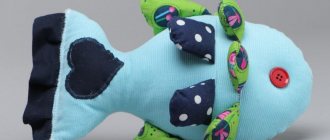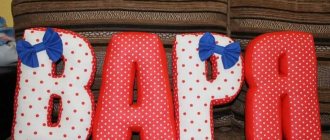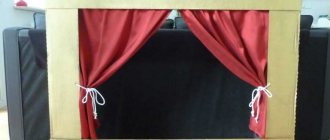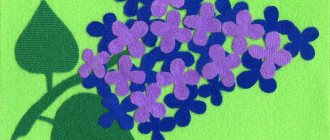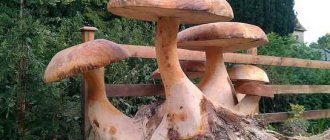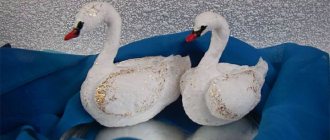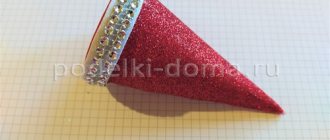Made from plasticine
The easiest way to make a mountain craft with your own hands is from plasticine. Schoolchildren often end up with used plasticine after school, which is no longer useful in other work. But for creating a layout - just right. If you mix all the colors, you get a brown shade that is suitable for simulating rocks.
You can use a thick cardboard cone as a base. You can first make a sketch of the future craft.
First you need to install the cone on the stand and fix it with plasticine. Paint the base of the mountain brown. The peak can be turned into a snow-capped peak by using white. Use a green tint to depict herbaceous vegetation along the base. Red and yellow colors will imitate flowers.
All that remains is to draw the gorges, washed out by water flows, and crevices with a stack so that the mountain takes on a natural appearance.
Paper nativity scene
Images cut out of cardboard, painted and mounted on a transverse base are ideal as figures.
You can also glue paper cones - these will be people's clothes, and glue circles to the cones - faces and hands. This way the figures will turn out voluminous. Large beads, plasticine or clay balls can also be used as a head.
The most difficult technique for making paper crafts is papier-mâché. To do this, you will need a ready-made mass or you can prepare it yourself.
You will need:
- Egg Tray
- PVA glue
Egg carton trays must be crushed and pour boiling water overnight.
- In the morning, squeeze out excess moisture, add a little PVA and knead into a homogeneous mass.
- When making large figures, it is better to use a frame made of foil, and then cover it with a mass of papier-mâché on top, forming your figure.
Env. world. How to sculpt a model of a mountain, volcano, hill, or ravine from plasticine?
The world. Social science. Modeling. Technology. 1-2-3-4-5-6 grades. How to sculpt a model/model of a mountain, volcano, hill, ravine, mountain range from plasticine).
Assignment on the surrounding world for 4th grade. You can also use clay and raw sand.
A sample of a section of the surface of the earth's edge using the example of a mountain, a mountain range made of plasticine.
In order for us to make a given model of a surface, a hill, a mountain, etc., from those presented in the question, we need to have an idea before our eyes of what it should look like. We study images of mountain ranges, mountains, remember them by color. In order to sculpt a convex part from plasticine, we first need to make a surface using thick cardboard, or from any box. The surface can be sculpted from a green plate, and a pond can be made from blue and light blue. Now we take brown or black and sculpt a mountain. We make the top white, since in the mountains at altitude the temperature is below zero, and the snow does not melt there.
If you need a very small model of a mountain or ravine, then it can be made entirely from plasticine.
Step 12: Installing the container
The plastic barrel serves as a gravity sump where any impurities will settle to the bottom. The barrel also provides access to water near the spring if a large amount of water is needed for irrigation at a time.
Plus, the barrel serves as a viewing well for assessing spring water. On my site, I used a blue barrel with a capacity of 80 liters, which I had to bury below the stream.
An important point is the angle of inclination of the pipe:
- When the pipe and overflow came out of the gravel bed, the water did not accumulate inside the artificial dam and did not destroy the plastic retaining wall;
- Installing a barrel should not lead to a decrease in flow for the same reasons. Water should be able to flow freely without pressure towards the barrel;
- Knowing the flow speed, it is easy to experimentally calculate the angle of inclination of the pipe. After a couple of tests, I found the slope angle I needed, at which the flow corresponded to 12 liters per minute.
I also used 3 universal rubber cuffs to seal the holes in the inlet pipe, outlet pipe and overflow pipe in the barrel.
Don’t forget about the pressure - the water should also quickly leave the barrel as well as enter it, so as not to create excess pressure in the gravel bed. Otherwise, the spring will quickly saturate it with water and destroy it.
Layout "In the mountains". Master Class
Svetlana Kundryukova
Layout "In the mountains". Master Class
To make the layout we will need :
1. A sheet of cardboard or fiberboard.
6. Gouache or watercolors.
7. Ceiling tile adhesive, PVA glue, tile adhesive.
Original topiary
You will need: multi-colored paper napkins, scissors, a stapler, cardboard or a foam ball, a sheet of green paper, a satin ribbon, double-sided tape, glue, a wooden stick for the trunk, a small pot, woolen threads or twine, decorative butterflies, a piece of foam.
Master Class
- Print out the ball template, transfer it to cardboard and make a tree crown. You can also use a ready-made ball.
- Fold the napkin in half twice and fasten it in the center with a stapler.
- Cut out a circle and assemble the bud, lifting each layer of napkin up.
- Make 36 flowers in the same way.
- Cover the ball with flowers using double-sided tape.
- Wrap threads around a wooden stick.
- Glue the flower ball to the trunk.
- Place a piece of foam in the pot and insert the stem into it.
- Make grass from a strip of green paper and glue it at the base of the trunk.
- Cut out the leaves and decorate the crown.
- Tie the pot with a ribbon and decorate the topiary with butterflies.
The napkin topiary is ready!
3D star
You will need: paper napkins, scissors, metal wire.
Master Class
- Open the napkin.
- Fold the napkin so that the 2 outer edges point toward the center.
- Turn the napkin 90 degrees and fold the 2 outer edges into the center. Repeat the action.
- Fold the resulting rectangle in half along the center line to form a tight strip, then unfold the napkin.
- Fold the accordion along the fold lines, unfold and fold the accordion again in the opposite direction.
- Wrap the accordion in the center with metal wire.
- Fold each corner of the napkin inward at a 45-degree angle. There should be 4 corners on each side of the accordion.
- Connect the ends of the accordions on both sides to make a star.
The voluminous star made from a napkin is ready! I recommend watching the video master class!
How to fold napkins for table settings - star. Napkin folding tutorial
Instructions on how to make a volcano out of paper and cardboard
A volcano is also a mountain, but it has no top. It is replaced by a depression called a crater. Most often, an erupting volcano is made, with fiery lava flowing down its slopes.
To make a volcano out of paper you will need decor (plasticine or paint) in bright orange and yellow.
Video master classes on how to make volcanoes
A volcano model for children's games and experiments can be created by following the instructions from the following video master class:
To make a small volcano, which can become a decoration for playing with toy soldiers, you need paper and plasticine. The construction stages are described in the following video:
Preparing for painting
The next stage is one of the most important. Painting the finished relief largely determines the realism of the entire layout. You should know well what kind of area you are depicting, what kind of flora there is. Season.
And again, it is advisable to have a lot of photos. If the area is close to you, it is easy to take as many photos as possible, especially details. A protruding tree root in the middle of the path, a loose stone, a dried tree. These details will help you give everything a special realism.
The painting stage itself is too voluminous and is no longer included in the scope of this article. Just be more attentive in nature, on the street, notice everything that surrounds you. There are no uniform methods for creating a landscape. We looked at one of perhaps the simplest and cheapest methods of creating nature on a shelf.
The article was prepared by educational teacher Valery Smirnov.
Municipal preschool educational institution kindergarten “Alyonushka” of the Pavinsky municipal district of the Kostroma region Abstract of the NOOD on speech development in the secondary group “Our Mothers” Prepared by Brueva M.N. 2022 Topic: “Conversation on the topic “Our Mothers.” Age group of children: senior Goal…
Municipal preschool educational institution kindergarten "Alyonushka" Pavinsky municipal district of the Kostroma region Summary of a walk in the senior group on the topic "Observation of a drop" Performed by Margarita Nikolaevna Brueva with Pavino 2022 Date 03/15/19 Venue: On the children's site...
Municipal preschool educational institution kindergarten "Alyonushka" Pavinsky municipal district of the Kostroma region Notes on cognitive development in the preparatory group Topic: "History of the emergence of paper." Integrated areas: social and communicative development, speech development, artistic and aesthetic development. Goal: to introduce children to the history of paper; Objectives: Educational…
Municipal preschool educational institution kindergarten "Alyonushka" Pavinsky municipal district, Kostroma region Summary of a mathematics lesson in the preparatory group "How to help Pinocchio?" Prepared by Brueva M.N. 2022 Integration of educational areas: “Cognitive development”, “Socio-communicative development”, Physical development…
Often children need a model of a mountain for school, play or other purposes. How to make it at home from scrap materials is presented below. This activity is exciting. The whole family can be involved in the process of creating a landscape. The list of materials from which a model can be made is huge and varied.
Papier mache
Here's how to make mountains out of paper for a model, imitating a mountain range:
- Crumple up newspaper sheets and moisten them with water from a spray bottle.
- Shape into mountain peaks or hills.
- In a bowl, dilute PVA glue with water in a 1:1 ratio.
- Tear newspaper or writing paper into pieces up to 10 cm in size.
- Soak the strips in glue and apply them to the desired area of the base. Apply 5-7 layers.
- Next you need to glue paper or white napkins so that later after painting the typographic font does not show through the paint.
- Color the slopes.
How to make a mountain layout more realistic? Coat the slopes with a thin layer of glue and sprinkle with sand, salt or semolina. Once dry, it can be painted to even out the background.
Now let's move on to making the landscape itself.
When all the lowlands and hills are marked on your sub-layout (that’s what the base of the layout is called), you can begin the relief itself. If you have ravines or a stream (river), then their bottom will be the lowest point of the entire layout. and relative to this point the entire relief must be raised. And here there are many methods for relief, but we need simpler ones, and preferably without the use of expensive and complex materials. First you need to make the frame of the hill itself. It can be made from sheets of cardboard or pieces of packaging cardboard (corrugated cardboard). The gaps between the sheathing can be filled with any waste material. This could be crumpled newspaper, unnecessary rags, scraps of foam (foam from packaging of household equipment will do).
If the filler is newspaper or rags, it needs to be fastened and secured with something. Varnish, liquid construction putty, PVA glue or any other cheaper solution will do.
If you filled the gaps with polystyrene foam, glue it (on the same PVA, it’s not that expensive). Then the foam plastic must first be trimmed, removing unevenness and fitting it approximately to the topography of the hill (mountain). At this stage of relief formation, it is advisable to have photographs of approximately the height that you are going to depict. Is it a rocky outcrop or just a moss-covered hill? This will help you now and in the future.
Let your sheathing filler dry thoroughly. Depending on the soil you choose (stones, grass, rocky outcrops), the further structure of the hill is formed. To soften the folds and make them look realistic, you can coat the frame with plasticine, mastic, or putty to level the walls and corners.
In general, at this stage, visit construction stores more often; as a rule, you will find everything you need there. Take a look at the pharmacy, they sell gauze and bandages soaked in plaster. Soaked in water and laid out on the relief, they perfectly convey the folds of the terrain. The shores and other areas of the area are formed in the same way. Remember about Russian roads and paths, which cannot exist without ditches and potholes. There should be no gaps, cracks (unless this is your idea), voids or even smooth areas anywhere on the layout, unless it is asphalt. The entire relief structure must be strong, reliable, not shake or sway. Otherwise, you will get cracks over time. Preparing for painting involves carefully treating the surface for the paint of your choice. Don't limit yourself to one type of paint, even if you have a full set of them. Aerosol paints, tinted water-based emulsion, gouache, tempera, watercolor, acrylic. Anything can come into play. Remember, each type of paint has its own special reflective feature.
DIY volcano
The volcano model is a rather interesting thing; it can serve as part of a large composition or as an independent model.
Some of them are simple, even a child in kindergarten can do them, and those that are more complex will appeal to schoolchildren during a labor lesson in primary school.
There is another type of volcano model - one might say, an “active” hill . The method of reviving it is more suitable for chemistry lessons, since it will erupt as a result of an ordinary chemical reaction.
It’s not difficult to make a model of a volcano with your own hands at home. For this you can use a variety of materials, such as:
Plasticine model
The easiest way to make a volcano with your own hands is to fashion a model from plasticine . To do this, you will need a platform for the model, for example, plywood or thick cardboard and a base (a cardboard cone or a plastic bottle), as well as plasticine. Step-by-step instruction:
- Attach the cone to the platform using dark plasticine.
- Cover the cardboard base with plasticine.
- Make multi-colored stains on the volcano cone. The green ones will represent grass, the red ones will represent lava flowing from the top of the volcano.
- At the top you can make a depression - something like a volcanic vent from which an eruption occurs.
- All that remains is to diversify the nature around the volcano itself. It could be small trees or just green grass.
- The plasticine volcano is ready!
You can make many fun and very beautiful crafts from plasticine. For example, models of great architectural buildings such as the Moscow Kremlin, the Baiterek monument in the capital of Kazakhstan or Big Ben in London. You just need to use a little imagination and patience!
Salt dough hill
You can diversify the dough layout by “revitalizing” it. To make it, we need salted dough (its ingredients: flour (400 grams), salt (200 grams) and water (150 ml)); as a base - a small glass, and for a stand - a sheet of plywood or cardboard. You will also need gouache paints, PVA glue, vinegar and soda. The manufacturing technology is as follows:
- First, prepare the salt dough by mixing all the ingredients until smooth.
- Then paint the stand the color you want, if needed (like green or brown).
- Place the glass in the center of the future model, and around it, mold the shape of a cone (volcano) from the dough. Unevenness is not a problem, because a real mountain is also not an ideal shape. After the shape is given, the dough needs to be dried, this can be done in the oven in about 20 minutes.
- After which the model should be painted with gouache. Don’t be afraid to mix colors and look for interesting solutions, because the color of a volcano can be absolutely anything. At the base there are more greens and light shades, closer to the top - brown and dark gray. A strip of hot lava of a bright red or scarlet color stretches from the vent to the base of the mountain.
- For an “eruption” to occur, you need to mix baking soda and vinegar. Pour a little soda into a glass inside the mouth of the hill and pour vinegar into it. To make the resulting foam look like real lava, tint the vinegar with red paint and enjoy the spectacle!
Instead of salt dough, you can use clay. True, you will have to burn it in a kiln if you want to experiment with the model of the hill.
Layout using papier-mâché technique
If you have accumulated a lot of unnecessary scraps of paper, you will be interested in how to make paper mountains with your own hands. You will need a plastic bottle (as a base, the “mouth” of a volcano), a thick sheet of cardboard, whatman paper, white paper, PVA glue and brushes, gouache. First, create the shape of a mountain. To do this, place a bottle in the center of a sheet of cardboard, secure crumpled sheets of newspaper around it to expand the base. The next step is to complete the frame. To do this, cut sheets of whatman paper into small strips, glue them first vertically onto the resulting shape, and then horizontally.
Once the frame is ready, you can begin the papier-mâché technique . The first 3-4 layers can be made from newspapers. They need to be torn into small pieces, soaked in water and stuck to the frame. Each layer should be coated with glue. It is better to make the last layer of white paper. After the work has completely dried, it can be painted.
Papier-mâché is a very interesting technique; in this way you can make not only a volcano or mountains, but also, for example, a yurt - a small portable dwelling in the shape of a dugout.
Crafts made from polyurethane foam
For the base of the layout, you can use pieces of foam plastic and cardboard. Cut pieces of different sizes from polystyrene foam, place them one on top of the other, gradually reducing the diameter of the mountain towards the top. Color them green, brown and gray, making streaks and transitions. Pour a little polyurethane foam onto the top of the hill so that it flows down the mountainside like lava. It should be red, so it also needs to be painted. If desired, the model can be varnished, and another model of the hill is ready!
How to make a volcano craft erupt
It will be very interesting for children to watch how the craft they made with their own hands comes to life. Making a volcano erupt is quite simple, but only adults should do it. The child’s task is to look and be surprised.
There are several ways to “start” the flow of lava from the crater of an artificial hill. The simplest is to mix water with soda and vinegar in a “crater” from a plastic bottle. Almost immediately a light smoke will begin to emerge from the vent.
Dishwashing detergent and regular food coloring will help enhance the effect. For a “vent” volume of 2 liters you will need:
- 1 tbsp. a spoon of any dish soap;
- the same amount of soda;
- 5 to 10 drops of liquid food coloring.
Place the mixture in the crater and begin pouring in the vinegar. Vinegar should be 6 or 9 percent, but not essence. Pour it in carefully until foam begins to appear. As a rule, a volume of ¾ of a 250 ml glass is sufficient.
It is best not to consider recommendations to use liquid nitrogen indoors to simulate a volcanic eruption. This is dangerous, the experiment can only be carried out in the fresh air and only if it is done by a professional. And it’s better to make small crafts “work” using improvised means.
Imagine, create with children and for children. This will not only diversify your life, but will also help you get closer to your child.
Paper or cardboard mockup
The simplest models are made from paper or cardboard. Parents can make this craft together with their preschooler, and an older child can make it on their own.
You need to take three sheets. The formats can be any, this will affect the size of the finished sample, but it is preferable to take A4, A3 and A2 with a density of about 180 g/m2. m. On a medium-sized sheet, use a compass to draw a circle and cut it out along the contour. Then a cut is made from the edge to the center, the circle is rolled into a cone and glued together - this will be the base of the volcano.
The second, smallest leaf is rolled into a tube. This is a muzzle, it also needs to be glued and put on top of the base. The third, largest leaf will imitate the ground; it can be crushed a little to imitate the unevenness of the soil. A cardboard volcano is placed on it.
To complete the work, the model is painted. For this you will need watercolor paints. If there are no paints, only pencils or felt-tip pens, then it is more convenient to first paint the parts and then assemble the structure. The top of the mouth can be sprinkled with bright sparkles - they will play the role of fire and lava. The “ground” is sprinkled with sawdust or sand, having previously been coated with glue.
Nativity scene with toy figures
Surely in every home there are small toys in the shape of animals and dolls representing people of a suitable size.
They can be used in a composition. This simplest craft option is also available to kids; together with their parents, they can choose suitable figures and find a place for them in the cave.
Paper mountains
The most accessible material that is available in every home is newspapers. How to make mountains with your own hands from paper is described below.
You need to place a plastic bottle on a stand. Cut strips of cardboard 2-3 cm wide and length equal to the height of the mountain. Place 5-6 pieces vertically, fasten them at the top with a stapler or glue, and decorate the slopes. In order for the mountain to take shape, you need to glue horizontal strips around the entire circumference at different heights. It turns out to be a “skeleton”.
Crumple up sheets of old newspapers or magazines and place them under the frame to give it strength. After this, you need to cover the surface with sheets of white paper. Double-sided tape or glue is used for fastening. Paint the blank.
History of the nativity scene
Initially, the nativity scene looked like a two-story box with slots in order to move the dolls in it. The top floor of the box was decorated like a cave, with the Star of Bethlehem glued on.
The interior walls were hidden behind snow-white rabbit skins, as white is the color of purity and innocence. There were always figures of the baby Savior, the Virgin Mary, Joseph, a donkey and an ox. Sometimes there were also Magi.
Such nativity scenes were made by ordinary peasants, as a rule, in winter, in their free time from agricultural work. The owners of the box, the nativity scene workers, themselves told stories and moved the dolls, sometimes boys from the church choir helped them with chants.
And the first such nativity scene, personifying the events of the Nativity of Christ, was created in 1223 by the monk Francis of Aziz. After that, they gradually spread throughout Europe and reached Siberia in the 19th century. In this way, even people who cannot read could become acquainted with Bible stories.
What is a volcano?
Before starting work, it will be interesting and useful for children to learn what a volcano is and what parts it consists of.
A volcano is a mountainous formation that appears naturally above faults in the earth’s crust, through which lava comes to the surface. Lava is magma that has come to the surface and has gotten rid of its gases. Magma is the liquid, burning component of the earth's crust.
A volcano is most often represented as a high mountain, from the mouth of which steam pours out and lava bursts out. This is not entirely true, it can not only have the shape of a mountain, but also be very low, like a geyser or a small hill.
Pay attention to the cross-sectional diagram of the volcano . Hot magma rises through the crater to the surface, where it turns into lava, escaping through the crater. During an eruption, being nearby is extremely dangerous.
In our article, you will get acquainted with the creation of various volcano layouts. You can make a cutaway model. This work will serve as a good teaching tool for children.
Geyser with sea salt
Taking a bath in such a geyser will become not only a pleasant, but also a useful pastime. Its almond oil will moisturize and nourish the skin, and the sweet and sensual aroma of ylang-ylang will lift your spirits in a matter of seconds. Few people realize how easy it is to make a bubbling geyser for a bath with your own hands. Meanwhile, its composition is so simple that any housewife will have the necessary ingredients in her kitchen. The main thing is not to forget about the proportions and monitor the absence of moisture throughout the entire working process. To prepare a geyser you need: 1 part base oils (almond, coconut, olive, burdock, flaxseed, etc.) 2 parts filler (herbs, sea salt, clay, cream, etc.) 2 parts citric acid 4 parts baking soda 2-3 drops of essential oil 2-3 drops of food coloring So, let's prepare everything you need for work: 1. Large bowl 2. The above ingredients. This master class uses almond oil and ylang-ylang ester. 3. Tablespoon 4. Mold for making geysers
Mix soda, citric acid and oil until crumbly. Citric acid must be ground in a coffee grinder or blender to a fine powder. After grinding, the acid must sit for a while, otherwise there is a risk of inhaling its volatile particles and burning the respiratory tract.
Let's add aroma using ylang-ylang essential oil. Its benefit lies not only in its pleasant aroma, it can have a beneficial effect on the skin. Treats eczema and dermatitis. It is also a recognized aphrodisiac.
Then divide the resulting mixture into 2 equal parts. Add pink sea salt and a few drops of raspberry coloring to one. We grind everything thoroughly.
In the second part we will add yellow sea salt and turquoise dye. Also mix until smooth.
The consistency of both mixtures should be identical and resemble wet sand. When squeezed in a fist, the mixture should not lose its shape.
We take one of the halves of the mold and begin to lay out our colored mixtures one by one, pressing them thoroughly with our fingers. It is important to compact the mixture tightly into the mold, otherwise the geyser may simply fall apart.
We also fill the second half of the form.
The next task is the most difficult in the whole process. It is necessary to forcefully press both forms to each other and, pressing firmly, connect them together, getting rid of excess mixture.
After twisting the mold halves a little, carefully remove them. First one.
Now the geyser needs to be thoroughly dried so that it becomes hard and convenient to store. This will take at least a day. After this time, you can immediately use the geyser, or pack it in cling film to protect it from moisture. Based on this recipe, you can also prepare soothing geysers with chamomile and lavender, invigorating geysers for morning baths with lemon and grapefruit essential oils, as well as nourishing geysers based on cream and honey.
Source
From salt dough
Using salt dough significantly expands the scope for creativity. The molded base is painted with paints.
It is necessary to knead the dough by mixing flour, salt and water in equal proportions. The dough should be tight. If you add dyes to it, it will acquire color. But for the mountain layout it is not necessary to add them.
A cardboard cone, foil or plastic bottle is used as a base. Place it on the stand and secure it. Paste over pieces of dough, giving the desired shape and working out the details. This workpiece must be dried thoroughly before continuing to work. During drying, cracks may appear on the surface. But in this case it will only add naturalness.
Paint with gouache or acrylic paints. This is how you can make a model of a mountain from salt dough.
Snow layout
The snow surface is made like this: the desired part is smeared with glue and sprinkled with brown powder mixed with boric acid to add shine. You can also make the surface of cotton wool (absorbent), which is spread in an even and thin layer on top of white paper. The cotton wool is sprinkled with boric acid on top. When the glued parts are dry, they are covered with putty made from chalk (tooth powder) and glue. Depending on the color that the soil should have, different paints are added to the chalk. The putty is applied in a thin layer, and in those places where it is required, it takes the shape of the necessary convexities, relief, protrusions, banks, etc.
The purpose of coating with putty is to hold the model together, smooth out or create unevenness, and make it dense and monolithic. When applying it, the putty can contain pebbles and roots that imitate one or another object.
The background of the layout can be painted with brown paint or sprinkled with wood powder over glue, or covered with dark paper. After finishing, the entire model, while it is raw, is sprinkled with diamond mounds, which makes it come to life, especially in the evening light.
The inscriptions are made on drawing paper in ink and placed under glass, like labels, and the layout is ready. Let's turn to making some details of the layouts.
Photo ideas for crafts on the theme of Christmas nativity scene
If the master can’t come up with new ideas for creating a Christmas nativity scene, he can use existing photos of compositions from craftsmen. Having been inspired by ready-made interesting options, you can make your own unique one. It is especially convenient to use basic step-by-step instructions from the masters.
Today you can buy a Christmas nativity scene ready-made in the store. But it’s much more interesting to do it yourself, putting your soul into the process and involving the whole family in it.
Rate this post
Step-by-step creation of simple mountains and terrain
Before you make paper mountains with your own hands, you can look at options for ready-made layouts and crafts. You can change the color and decor of the product, or you can completely repeat it using step-by-step master classes.
Layout examples
A simple option for making mountains using cardboard and white sheets looks very original. It can become an interior decoration.
To make it you will need to do the following:
- Determine the size of the composition.
- Cut out triangles of different sizes from cardboard.
- To make snow-capped peaks, you can use white paint, a marker or white paper.
- Cut out clouds and the moon from white sheets.
- Glue the composition onto a dark blue cardboard base. Alternate the vertices so that they do not coincide with each other.
To make a daytime landscape, you need to replace the moon (white circle) with the sun (yellow circle) and make the background light blue.
Paper mountains in the trendy style of polygonal sculpture are glued together from pre-printed drawings. This layout is suitable for creating a landscape composition.
To make such a relief, you need to print a ready-made template, make cuts and folds along the intended lines, then assemble the layout.
Schoolchildren will be able to make snow-covered rocks made using the origami technique during creativity lessons. Such works are suitable for exhibition at children's art competitions.
We make a pyramid, and then you can place paper cut out in the form of snow slopes (as in the photo above).
Video master classes on how mountains are made
A paper mountain model can be made for room decoration or to decorate a photo zone. An example of creating cone-shaped rocks with snow and fir trees is shown in the video:
And the next master class tells in detail how to make an applique in the form of a mountain landscape with your own hands:
Model made of polystyrene foam and polyurethane foam
Before making a model of a mountain from polyurethane foam, you need to prepare the base. This could be a sheet of cardboard or a piece of plywood. Squeeze a stream of spray onto it from the bottle and form a mountain. It should be taken into account that when the polyurethane foam hardens, it expands, so the dimensions will increase. When working, do not touch uncured material with your hands!
Leave for a day to thicken. Use a sharp knife to cut off excess. The top layer can be made of papier-mâché, or simply painted in the desired colors.
You can make a mock-up of a mountain from a thick piece of polystyrene foam. Several layers of this material are pricked on top of each other, fastened with toothpicks. Then the excess is cut off and the top layer is decorated.
Your imagination will tell you how to make a model of a mountain. You can use a large number of available materials. For decoration you can use twigs, cones, artificial plants. Imitation of water can be done using a glue gun.
Fabric nativity scene
Dolls for a nativity scene can not only be drawn or molded. They can also be sewn. Felt is perfect for this. From hard felt you can make cones - bodies, and from soft felt - heads. You can also make stuffed toys.
For those who know how to crochet, it will be great to use their talent and make figurines of angels in this way, for example.
